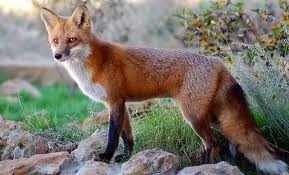Tom Parkinson's monthly column, introducing the diverse range of flora and fauna on show at Sanctuary Lakes.
Last week I cleverly managed to make a certain par into a bogey. Despondent, I left the tenth green and there in the rough at the back of the eighth green, openly bold, without a care in the world, trotted a Red Fox. The Sanctuary Lakes golf course always has traces of Foxes - paw prints in the sand bunker, droppings, discarded kill and a year or two back, one that would follow golfers around the first, fifth and ninth eyeing stray golf balls. There seemed to be a Fox's den between the ninth tee and the tenth green. After a slightly misplaced "power swerve" shot, one of my playing partner was searching the area and found a collection of twenty plus balls neatly placed outside the Fox hole!
Not only are Foxes on the golf course, but I have one who regularly uses my garden as a place to relax and enjoy his midnight feed.
In many cultures, the Fox appears in folklore as a symbol of cunning and trickery. The term foxy means the obvious "having the qualities of a fox" but it can also be attractive and sexy, as well as red-haired. And "to outfox" means to beat in a competition of wits, the synonym of outguess, outsmart or outwit.
Foxes are probably the most type cast animals in literature. All the numerous Aesop fables and the French Reynard stories cast the Fox as one who wins in the end by stealth, cunning and intelligence.
 Red Foxes (Vulpes vulpes) were introduced to the Port Phillip District as early as 1845 for the purpose of the traditional English sport of fox hunting.
Red Foxes (Vulpes vulpes) were introduced to the Port Phillip District as early as 1845 for the purpose of the traditional English sport of fox hunting.
Foxes are members of the Canidae family and are related to jackals, coyotes and wolves. There are as many as 21 different species of fox throughout the world, but only the Red Fox is found in Australia.
A Red Fox has big ears, a bushy tail, a beautiful rich reddish-brown coat above, with a distinctive white chin, chest, belly and tip of their tail. Foxes have a narrow chest, strong legs, with long, moveable sharp claws that give foxes excellent climbing and burrowing abilities.
In the main, Foxes are nocturnal hunters, being most active in the evenings and early mornings. Fox family groups usually occupy well-defined home ranges. Scent markings with urine, and secretions from anal glands, define the home ranges.
Sanctuary Lakes lies in the midst of perfect Red Fox territory. Stretching from Altona Meadows to Werribee South, via Point Cook Air Base, Cheetham Wetlands and the Golf Course, all bristling with Rabbits, Hares, Water Birds, Frogs, and Grubs, in fact everything a Fox would want on his menu. In an evening, Foxes will travel up to 10 km scavenging for food. They have long, sharp teeth, very quick reflexes and kill by multiple bites to the head and neck. Foxes will only eat a bird's head and neck. Whereas prey such as rabbits typically have their tail, ears and tongues eaten first and then they prize open the chest cavity to eat the internal organs.
Both male and female Foxes can be reproductively active at the age of one year. Females (vixens) usually come into heat for only a few days between the months of July to October, and most cubs are born between August and September. The average litter has four cubs, but can be as high as ten. Cubs are suckled for a period of around four weeks. They generally emerge from a breeding den during spring. Only one third of Cubs survive the first 12 months. In the wild, Fox's lives are comparatively short between three to four years. Even with short lives, the Fox still has developed very successfully. Due to this rapid spread and ecological impact it is classified as one of the most damaging invasive species in Australia. There can be no doubt that the fox has played a major role in the decline of ground-nesting birds, small to medium sized mammals such as the greater Bilby. Land use change is cited as one of the key reasons for decline in many native species. Predation by foxes has also been a significant contributor to native animal decline and continues to undermine recovery efforts.
Attempts to cull foxes in Sanctuary Lakes has proved difficult. Obviously shooting is far too dangerous in such a populated area. The numerous domestic animals in the Resort make poisoning equally impossible. Parks Victoria are just culling enough to hold the numbers on the wetlands at an acceptable balance before becoming the invasive danger to other animals.
All that being agreed, I still have a sneaky admiration for the Red Fox, visually one of the most elegantly impressive animals and with an attitude of a larrikin. Head held as though inquisitively curious at their surroundings, it trots lightly in the soft evening shadows on the Lake's esplanade and seemingly nodding to passing humans as an equal. We should also thank the Red Fox for protecting the Flora of the Resort and Golf Course by keeping the rabbit population to an absolute minimum.
Good and bad they truly fit the description of our "Foxy Neighbour".